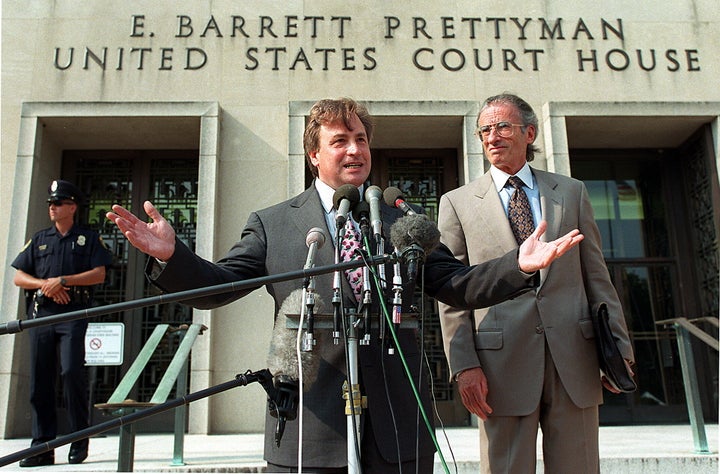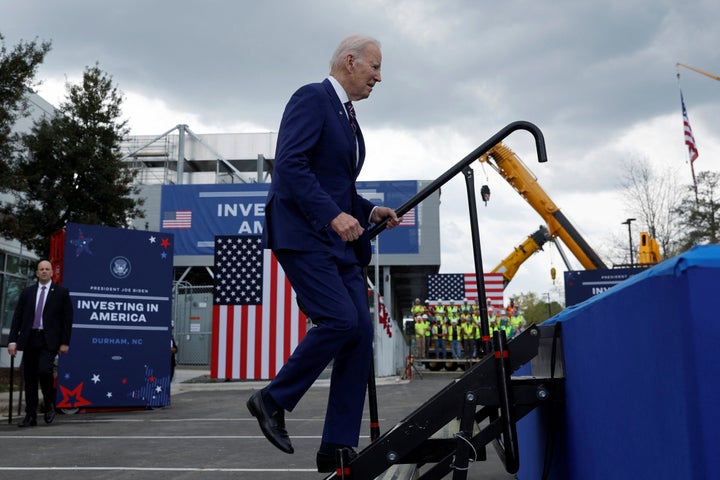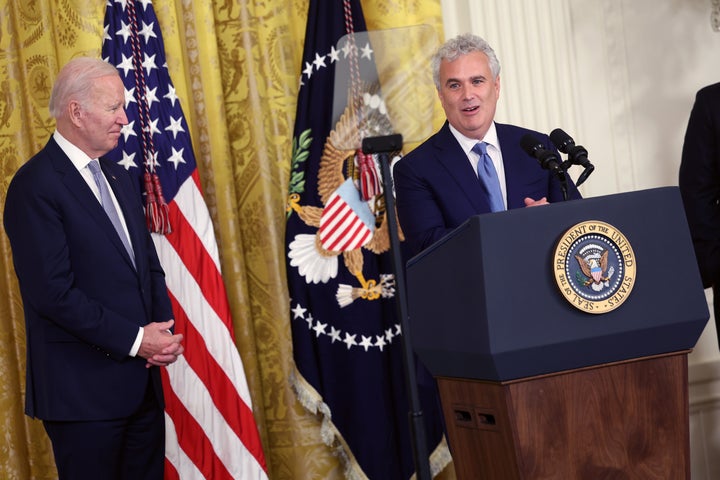If a White House pivots to the center, but doesn’t wage a messaging campaign about it, did it actually pivot?
Decisions over the course of March — to back a Republican-led effort to undo an overhaul of the District of Columbia’s criminal code, potentially embrace restrictive immigration measures, and approve a massive oil drilling project in Alaska — have prompted speculation that the White House is borrowing a page from former President Bill Clinton and pivoting to the ideological center ahead of President Joe Biden’s expected reelection announcement in the coming weeks.
There would be a certain logic to an ideological shift. While the Democratic Party greatly outperformed expectations in the 2022 midterms, Biden remains unpopular and concerns about the economy are widespread. Claiming the center of the electorate could provide a boost against former President Donald Trump or Florida Gov. Ron DeSantis, two potential 2024 opponents who support right-wing stances on major cultural and economic issues.
Administration officials, however, are rolling their eyes at the media wags and worried progressives pushing the pivot narrative. They argue that Biden’s center-left stances have barely shifted, and note that Biden’s larger agenda — epitomized recently in the State of the Union address and his budget rollout — have won plaudits from left-leaning members of Congress.
“The main two yearly moments when presidents articulate their full vision for the country are the State of the Union and their budget release,” White House spokesperson Andrew Bates told HuffPost. “Tellingly, the same outlets that over-torqued on a nonexistent ‘shift’ wrote that every segment of the party couldn’t have been more supportive of what he proposed in both.”
Compared with its boasts about the budget and the accomplishments of Biden’s first two years in office — Biden started a nationwide tour to hype them with a trip to North Carolina on Tuesday — the White House has been apologetic about the decisions on immigration and the environment, insisting the courts have tied Biden’s hands. Announcements on the two issues have come from Cabinet departments rather than from the loudspeaker that is the White House press office.
“My strong inclination was to disapprove of it across the board,” Biden said of the Willow Project — a ConocoPhillips oil drilling project that environmentalists say amounts to a betrayal of his pledges to fight climate change — during a news conference in March. “But the advice I got from counsel was that if that were the case, I may very well lose ... [a potential] case in court to the oil company.”
And with the District of Columbia law overhaul, administration allies note that Biden has consistently tried to fend off attacks claiming he’s weak on crime and has spent recent years slamming the GOP for opposing additional police funding — steps they view as in line with his longtime, well-documented tough-on-crime stances.
“Everyone’s acting shocked the crime bill guy doesn’t like carjackings,” one Biden campaign alum, requesting anonymity to critique the media, told HuffPost, referring to the 1994 legislation that Biden helped write. “It’s absolutely ridiculous.”
Any comparison of Biden’s recent maneuverings with Clinton’s three decades ago should cast major doubt on the idea that the White House is intentionally trying to break with progressives or otherwise reposition Biden. When Clinton moved to the center, the White House made sure everyone knew about it. After all, if the aim is to adopt moderate policies for political gain, it’s important to make sure moderate voters know about those policies.
‘Triangulation’

Clinton’s pivot occurred in the wake of Democrats’ huge losses in the 1994 midterm elections, a wipeout far worse than Democrats’ electoral performances in 2022. For the first time in 40 years, Republicans had won control of both the House and Senate, a monumental shock. Clinton saw the loss as a signal of the dysfunction in the party’s congressional wing and his own failure in relying on it to pass his program.
Clinton had sought to avoid the acrimony that President Jimmy Carter engendered when he butted heads with congressional Democrats in the late 1970s. Clinton tried to work closely with members of his party when he came into office in 1993, but saw so many of his programs, most notably his health care reform plan, fail to win support in Congress.
Following Democrats’ midterm defeat, Clinton brought his former adviser Dick Morris into his inner circle to help plot a path to reelection. Morris, a Republican consultant who worked with Clinton when he was governor of Arkansas, brought lessons with him from his work in France for conservative party leader Jacques Chirac.
When Chirac’s conservative coalition won control of the National Assembly in 1986, Socialist Party President François Mitterrand appointed him prime minister and allowed him to enact parts of his domestic program. This effectively took the wind out of the sails of Chirac’s momentum, and Mitterrand defeated him easily in the 1988 presidential race.
Morris wanted Clinton to apply Mitterrand’s strategy to the new Congress led by House Speaker Newt Gingrich. To do this, Clinton would “triangulate” by placing himself between and above the poles of congressional Republicans and Democrats. He would allow Republicans to enact some parts of their program while working to twist them to his own aims.
This strategy was all out in public by the summer of 1995 when Clinton embraced Republicans’ goal of a balanced budget and released his own proposal, much to the consternation of Democrats.
“Congressional Democrats find themselves in their deepest disarray in nearly 20 years, more divided as a party than they were in November and estranged from their own President to an extent reminiscent of when Jimmy Carter occupied the Oval Office,” the Los Angeles Times reported in June 1995, following the release of Clinton’s proposal.
By November, The Washington Post’s Lloyd Grove reported that Morris’ triangulation strategy had become the “bewitching buzzword of Bill Clinton’s Washington.” (Morris would go on to lose his job shortly before the 1996 election after allowing a sex worker to listen in on conversations between himself and the president. He’s since become a right-wing pundit and frequent critic of the Clinton family.)
In his 1996 State of the Union address, Clinton declared that “the era of big government is over,” a full-on rejection of the party’s long-standing positioning since the advent of the New Deal in 1933.
Biden’s political situation is quite different from Clinton’s. Democrats’ loss of Congress in 1995 set off the current era of extremely close political competition. From 1955 to 1995 the party controlled the House, as well as the Senate for all but 1981 to 1987. Over the ensuing three decades, party control has flipped four times in the House and five times in the Senate. The fates and interests of the presidential and congressional wings are much more closely intertwined.
What Biden Is Doing

Biden’s purported centrist pivots have not been telegraphed in this way. Nor have they come at the expense of congressional Democrats. Instead, the party is almost entirely unified around his agenda, while his moves to the center also have the backing of vulnerable incumbents in Congress.
After Biden announced his support for undoing the District of Columbia criminal code overhaul, more than half of Senate Democrats backed it. House Democrats were annoyed not by Biden’s embrace of the policy, but by the fact that those in potentially flippable seats — who already voted against it — could not join him in a political safe harbor.
Biden’s approval of the Willow Project also generated little protest from congressional Democrats, and it was a major priority of one vulnerable incumbent — Rep. Mary Peltola (D-Alaska). The administration also softened the blow by designating waters along the Alaskan coast as off-limits to drilling and creating two new national monuments a week later.
Immigration is the issue that seemingly saw Biden make the sharpest turn and that congressional Democrats have protested the most, even if Biden’s movements remain far from final. The administration is discussing restarting the practice of detaining families that cross the U.S.-Mexico border illegally, drawing backlash from Senate Democratic leaders and Hispanic House members alike.
“Family detention had disastrous effects on migrant families and children, without any corresponding improvement in border security or deterrence,” 19 Democratic senators wrote to Biden on Monday. “We urge you to learn from the mistakes of your predecessors and abandon any plans to implement this failed policy.”
The administration insists that in addition to a lack of broader congressional action, the May 11 end of Title 42, a pandemic-era provision that has allowed it to quickly expel asylum applicants, has limited Biden’s options when dealing with the ongoing surge of asylum-seekers at the border.
The one thing that unites all three decisions is that the White House is not aggressively pushing them as key to Biden’s agenda or reelection bid. Instead, the administration launched his nationwide tour last week to highlight his accomplishments in office so far, most of which — like the Inflation Reduction Act and the American Rescue Plan — are seen as embodiments of the progressive populist economics that Biden has embraced.
On the tour’s first stop in North Carolina, Biden mentioned his push for “Congress to pass ... [an] assault weapons ban,” “the progress we’ve made building an economy from the middle out and the bottom up, not trickle down from the top down,” and “the most transformational investment in our climate ever.” He also criticized outsourcing by “corporate America” and said every American should have the choice to join a union.
He did not mention the border, crime in the nation’s capital or the Willow Project.
Rep. Ro Khanna (D-Calif.), who co-chaired Vermont Sen. Bernie Sanders’ presidential campaign in 2020, said Biden has been a “much more progressive president than I expected,” adding that he saw the 80-year-old Biden as a bridge to a more progressive era.
“At its core, [Biden’s administration] is a rejection of Reagan neoliberalism and a push towards a progressive economic direction in the tradition of FDR,” Khanna told HuffPost, referring to Presidents Ronald Reagan and Franklin D. Roosevelt. “Now, I want that project at a much bigger scale and a much bigger speed, but that is his project.”
While Clinton used his first post-midterms budget to adopt a major GOP policy goal, Biden has done nothing of the sort. He has ruled out entitlement cuts sought by the GOP, and his own budget contained tax increases on the wealthy and the monthly child benefit that Democrats successfully enacted during the COVID-19 pandemic.
Khanna said he thinks Biden’s continued embrace of a more populist economic stance is simply smart politics.
“He understands that having a progressive orientation to economic policy creates a winning coalition in American politics,” Khanna said. “I’m confident he’s not going to use a Bill Clinton political strategy because it won’t work in 2024. I’m not counting on his conviction — though I do think he believes it. I’m counting on his political acumen.”
The Zients Theory

Among some progressives, however, there remains a worry that the White House could be undergoing an ideological shift without necessarily meaning to. They note that Biden’s recent moves have coincided with the beginning of Jeff Zients’ tenure as chief of staff, replacing progressive favorite Ron Klain.
There’s little question that Zients, a former Barack Obama administration official and private equity CEO who started as Biden’s COVID-19 czar, is a more moderate figure than Klain. Some progressives have speculated that the chief of staff could even be inadvertently pulling the administration in a centrist direction, limiting Biden’s populism and alienating young voters in particular.
Progressives point to surveys showing a decline in Biden’s approval rating among young voters in recent months, and other indicators that the advancement of the Willow Project could hurt Biden with his most loyal age cohort. Many passed around a survey from Data for Progress, a liberal polling nonprofit, showing a steep drop in approval on climate issues from voters between the ages of 18 and 29.
“It definitely appears to be some kind of pivot,” said Jeff Hauser, the executive director of the progressive Revolving Door Project, which closely follows presidential appointments and personnel moves. “The absence of any sort of aggressive populist move by the administration is as loud as the rightward moves on climate and immigration.”
The administration has scoffed at this, noting that Republicans and moderates used to similarly point fingers at Klain for any left-leaning move the administration made.
“Anyone who’s unaware that Joe Biden makes these calls is telegraphing that they don’t know the first thing about this White House,” said Bates, the White House spokesperson.
